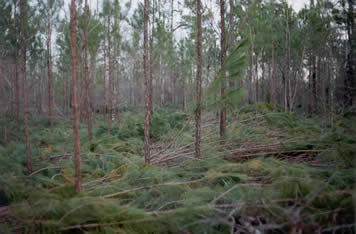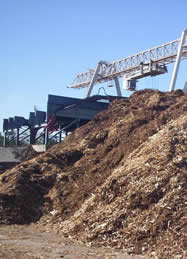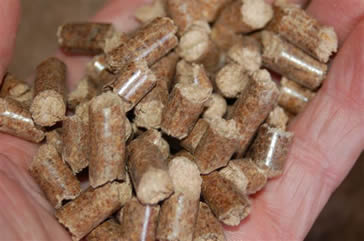Forest bioenergy is the use of renewable forestry biomass to produce energy products. Forest biomass is any plant matter or tree material produced by forest growth that can be converted to an energy source. It includes agricultural materials, tree residue from managed forests and wood waste from urban areas.
Forest landowners and existing forest industry have the potential to grow this new bioenergy industry rapidly by providing the needed biomass fuel and infrastructure for new mills that will produce wood pellets, industrial heat, electricity, and transportation fuels. Maintaining a balance of forest growth and utilization in the long term is an important part of sustainability.
Types of Forest Biomass
Merchantable Stem Wood
The wood in the stems of sound trees greater than 5″ in diameter at breast height (dbh) has been traditionally used for lumber, wood panels, paper, and chemical products. Trees with dbh of 5″ – 9″ are typically used for paper and chemical products and are lower in value. Thinning of forest stands is a major source of these smaller trees. Trees greater than 9″ dbh can be used for lumber and other building products, and are higher in value. Defects in trees sometimes will cause larger diameter trees to be used for lower-value products. These trees are termed “cull trees.” Much of Georgia’s 7 million acres of planted timberland and 17 million acres of naturally regenerated timberland is managed for these “traditional” products. The stem wood in lower value small diameter trees will be used by some bioenergy facilities for energy production. The higher cost of wood from larger diameter trees will limit their use to higher value products, such as lumber and plywood.
Tops and Branches of Harvested Trees

The normal whole-tree timber harvesting methods used in Georgia result in large volumes of wasted wood and bark in the tops and branches of trees harvested for their stem wood. These tops and branches are often referred to as logging residues. They are left in piles at the log loading decks or they are scattered out across a timber harvest area, at additional cost. Piles are often burned as a disposal means. Although some branches and tops are broken and scattered during the harvesting operation, much of them could be chipped and used for bioenergy operations.
Understory and Cull Trees

Trees less than 5″ dbh and other cull trees can be harvested during normal harvesting or thinning operations and used for bioenergy. These smaller trees do not meet the standard for higher-value products and are normally disposed of at an additional expense to the landowner, when preparing a forest site for reforestation. These trees must be harvested during a traditional harvest and not at a separate time, to take advantage of the cost efficiencies. In addition, cost of harvesting volumes of biomass is inversely related to tree size. Therefore, the portion of the understory in very small trees and shrubs cannot be harvested with traditional forestry equipment because of high costs.
Fuel-reduction Thinning

Naturally regenerated forest stands of southern pine species are often overly dense, sometimes with thousands of trees growing on each acre. A thinning operation that results in a forest stand of 500 – 700 trees per acre and less understory shrubs will improve residual tree growth and reduce the hazard of damage from wildfire. It is best to perform these thinnings at early ages, usually when the forest stand is less than 10 years old. The small removed trees and underbrush can be used for bioenergy. These thinnings can be done in a variety of ways and with a variety of equipment types. Traditional forestry equipment can be used in conjunction with a chipper, if trees and shrubs to be removed are not too small. The development of various types of biomass baling systems is also occurring to reduce transportation costs and improve efficiencies for smaller understory harvests and forest improvement operations.
Mill Residues

Mills within the forest industry produce residues as a by-product of their manufacturing process. These residues include: wood chips, bark, sawdust, shavings, and other coarse wood pieces. Almost 100% of these residues are currently used to produce additional products, including 49% going to energy products.
Urban Wood Waste
There are several sources of waste wood from metropolitan and other developing areas. These sources include construction waste, wood from building demolition, disposal of wooden pallets, and others. These materials are usually low in moisture content and provide an excellent fuel for bioenergy combustion systems. Use of these materials also prevent their disposal in landfills. Care should be taken to ensure that wood treated with chemicals and hazardous materials are not utilized.
Four types of energy products can be derived from forest biomass.
Thermal Energy
Thermal energy includes the heating of buildings, heating of water, and heating that is required for certain manufacturing processes. It also includes the production of heat for drying materials, such as lumber, paper, clay, and other products. The heating is produced by direct combustion within boilers, gasifiers and furnaces. Steam boilers and hot water boiler systems fired by wood chips or bark are often used. Wood pellets can be used in furnaces, heaters, and in the larger boiler systems.
Electrical Generation
Electricity can be generated through the use of steam turbines powered by steam from boilers using wood chips, bark, or wood pellets as fuel. Cogeneration is achieved by producing electricity in this manner while also using the steam for a thermal energy need. The wood fuel can also be combusted within gasification systems to produce a synthetic gas, similar to natural gas. The synthetic gas is then combusted to produce steam and electricity, or the gas can be used directly in a gas turbine for electricity production.
Transportation Fuels

Ethanol, methanol, butanol, and BTL diesel are all liquid fuels that can be produced from cellulosic biomass. The two general conversion technologies used are enzymatic hydrolysis and thermo chemical. Clean wood chips can be converted to alcohol fuels (ethanol, etc.) using enzymatic hydrolysis. Biomass-to-liquid diesel and alcohol fuels can be produced through thermo chemical conversion of any forest biomass material. Gasification and pyrolosis can be used within the thermo chemical conversion methods.
Wood Pellets

Although wood pellets are a product, they are actually a fuel that can be used to produce the energy types above. They are most easily produced from sawdust and other mill residues. However, small diameter trees can also be chipped and utilized for wood pellets. Wood pellets are produced using pellet presses that force the sawdust through holes in a die using rollers. The natural resins in the wood provide the “glue’ necessary to hold the pellets together. Wood moisture content must be in the 10-12% range, so drying is often required during the process. Wood pellets can be used in pellet heaters, furnaces, and boilers. The major use of wood pellets is by European-based utilities that co-fire wood pellets with coal to produce electricity. Large quantities of pellets are also used in residential heaters and furnaces in Europe, Canada, and the northern U.S. Georgia has the potential to use pellets within several industries, such as the poultry industry to provide heat to poultry houses. Pellets have the advantages of being uniform for ease of fuel handling (conveying), dense for ease of transport, and low in moisture to produce more energy.
Forest Biomass Sustainability
Forest sustainability has been defined as growing and utilizing forest resources in a way that meets the demands of the present without compromising the ability of our forests to meet the demands of the future. Maintaining a balance of forest growth and utilization in the long term is an important part of sustainability. In addition, other forestry benefits and attributes should be recognized when growing and harvesting forests for any product.
Biomass Supply
GFC cooperates with the U.S. Forest Service in conducting forest inventories through the Forest Inventory and Analysis program (FIA). The Commission also conducts industry surveys, which quantify forest resource use and residue production. Data from these and other sources are used to provide statewide and local assessments of forest biomass. The Commission has calculated that over 9 million tons (oven dry basis) of unutilized forestry biomass could be captured by the bioenergy industry each year based on the Forestry Biomass Estimates for Georgia, General Statewide Assessments.
In addition, Georgia’s timberlands are growing over 9 million tons (oven dry basis) more wood each year than is being removed. These data sources and analyses indicate that expansion of the bioenergy industry can be accomplished without threatening sustainability of the forest resources.
Biomass Harvesting
Forestry Best Management Practices (BMPs) for water quality should be followed during biomass harvests. In addition, landowners should be aware that any intensive forest biomass harvest may affect other management objectives including: maintaining soil productivity, wildlife habitat, and biodiversity. The GFC manages a forest water quality program and performs compliance surveys on BMPs implementation.
Helpful Resources
| Title | Description | Document Type |
|---|---|---|
| 2023-07-25-BiomassSupplierList | ||
| Analysis of the Feasibility of Forest Biomass Production (2011) | ||
| Biomass Assessment Services for Industry (2008) | ||
| Biomass Designation and Tracking for Renewable Biofuels Production | ||
| Energy Balance of Wood Pellets | ||
| Forestry Biomass Assessment for Georgia (2021) | ||
| Georgia Department of Economic Development (GDEcD) | GDEcD is the state’s lead agency for attracting new business investment, encouraging the expansion of existing industry and small businesses, aligning workforce education and training with in-demand jobs, locating new markets for Georgia products, and planning and mobilizing state resources for economic development. | External Website |
| Mechanisms for Securing Longterm Forest Biomass Supply | ||
| Overview of Timber and Biomass Supply Chain |
Forest Biomass FAQs
What is biomass?
Biomass is plant matter that can be converted to an energy source. It includes agricultural materials, tree residue from managed forests and wood waste from urban areas. Find out more about GFC's biomass efforts.
How does biomass from forest residue differ from corn biomass?
It takes less energy to grow forest biomass and convert it to ethanol than it takes to grow corn and convert it to ethanol. In addition, the entire process emits fewer greenhouse gases when using forest biomass. Find out more about GFC's biomass efforts.
What can be done with biomass?
Biomass can be converted to energy-producing ethanol and wood pellets. Find out more about GFC's biomass efforts.
What is ethanol?
Ethanol is a "clean" gas alternative that emits no additional greenhouse gases when burned. Any gasoline powered vehicle can run on an E-10 or 10% ethanol blend. Hybrid or flex fuel cars can use an 85% ethanol/15% gas ratio. Find out more about GFC's biomass efforts.
What are wood pellets used for?
They can be used to fuel heaters and furnaces in commercial and some residential applications. They can also be used by industry to produce steam and electricity. They are easy to handle, have high energy value and are inexpensive to transport. Find out more about GFC's biomass efforts.
How does the production of biomass and ethanol affect the environment?
Biomass is made from forestry and agricultural by-products. Georgia's forestry industry already has the infrastructure in place to gather and deliver these materials to processing locations. The production of biomass, conversion of biomass to ethanol and the burning of ethanol are considered "green" processes. They give off no harmful greenhouse gases. Find out more about GFC's biomass efforts.
Why develop the biomass industry?
The use of ethanol can dramatically reduce our country's dependence on foreign oil. It is also more environmentally friendly than other fuels, which emit harmful greenhouse gases. Find out more about GFC's biomass efforts.
How does Georgia fit into the biomass/ethanol picture?
Georgia already has a thriving Forestry industry, containing the necessary infrastructure needed to bring biomass to a world market. It has the resources to accomplish this mission, including Forestry professionals, leading researchers, a ready supply chain and government support. Find out more about GFC's biomass efforts.
How quickly can Georgia become a leader in the production of biomass and ethanol?
Researchers estimate Georgia could have a biomass production and export system in place within three years. Find out more about GFC's biomass efforts.
What would be the economic impact of a new biomass industry in Georgia?
Estimates are that one large biorefinery would have a $100 million direct impact and a much larger indirect impact on the Georgia economy annually. Find out more about GFC's biomass efforts.
